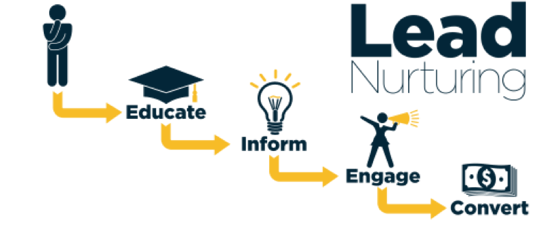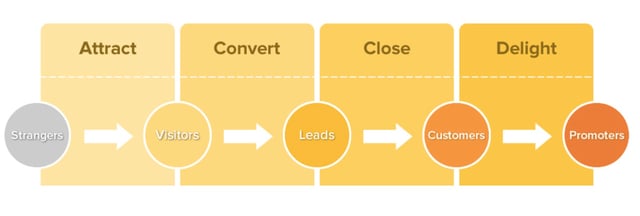Estimated reading time: 5 minutes, 45 seconds
Take a look at some common myths about the buyer's journey and lead nurturing, and how you can successfully nurture qualified leads through the sales funnel.
Research shows that 50% of leads who get qualified by marketing are not ready to buy yet. With lead nurturing you can help move those leads through the sales funnel and convert them into customers.
As a marketer you’ve probably been exposed to the sales funnel at some stage. But more than likely, don’t really know what each step in the process requires and where you, as a marketer fit in. And it goes without saying that understanding who you’re nurturing, when, and why, is vital.
So, we’ve taken a look at the common misconceptions marketers have when it comes to lead nurturing and the sales funnel, and have some advice and tips to help you successfully nurture your leads.
Common misconceptions about lead nurturing

Image: via Hubspot
1. Once the lead is passed to sales, nurturing isn’t my job
This is something a lot of marketers believe. Once they hand that lead over to sales, there’s no need to nurture because it’s the sales team’s job. The truth is, it’s always marketing's job to nurture, no matter what stage of the process the lead is in.
Your sales team may know customer buying trends best, but nurturing is time consuming and a sales person doesn’t have the time to focus on nurturing when they need to be selling. This is where you’ll hear a lot about sales and marketing alignment. It’s up to sales to give you the information you need about that lead so that you can nurture them until they are ready to buy.
2. Once a lead becomes a customer nurturing stops
Nope! Delight is an important part of the Inbound Methodology for a reason. It’s easier to upsell or cross-sell to an existing client than it is to convert a new one. That’s why a marketing automation tool like HubSpot is so important. It allows you to follow a lead’s journey through from stranger to customer, and captures all the relevant data along the way.
Once a lead has become a customer, this is where you need to start sending them smart content, offer them specials, and nurture them, not only to buy more, but to become promoters for your brand.
3. Lead nurturing is about the numbers
This is a myth that will empty your contacts list fast. Lead nurturing is not about sending content to everyone, it’s about sending the right content, to the right leads, at the right time. Segmenting contacts and distribution channels is so important. You probably wouldn’t send your great grandmother an email about the latest tech trends, right? She would have no interest in it and probably wouldn’t even know how to open the email. So why would you send a lead info that isn’t relevant to them?
Before you start nurturing leads, segment your lists by buyer personas, which stage they are in their buyer's journey, and even their preferred distribution platform. A properly segmented list of five people will yield higher results than a generic list of 100 people.
4. Nurture campaigns are ‘set it and forget it’
Definitely not. Like everything in the world of inbound, analysing the data and making changes accordingly is key. Nurture campaigns like all campaigns should be monitored and adjusted over time.
Each nurture campaign should be created and designed for a specific persona. As time goes by and you gather more info on your personas, things might change. Which means your nurture content will need to change too. Make sure you maintain both your personas and lists so that you know what to send to who.
Common misconceptions about the Sales Funnel
 Image: via Hubspot
Image: via Hubspot
Let’s start with a quick definition of what the sales funnel is. In a nutshell, the sales funnel is the process you use to convert prospects into customers. Each company will have their own version of a sales funnel but the fundamental process is the same.
1. A Sales Qualified Lead (SQL) has to tick all the boxes
Not true. Depending on what your company needs from a lead, an SQL could be someone who fills in a key form or someone who interacts before filling in a form. The criteria for an SQL is 100% dependant on what your salespeople need to begin their sales process.
The same goes for a Marketing Qualified Lead (MQL). You know how people interact with your company and should set the criteria accordingly. If you know that people who interact on social media are just looking for great content, their interaction score may not qualify them as an SQL, but rather an MQL.
Also remember that where a lead is in their buyer’s journey is also key to segmenting into SQLs. Someone in an Awareness stage would not qualify as an SQL even if they have interacted a lot with your company.
2. You need an in-house team
This is where times have changed. Before, it was important to have an in-house team to manage your sales funnel and ensure leads are going to the right place. But CRM tools have changed this.
Now with a tool like Hubspot CRM, you can track your sales pipeline from prospect to customer. Also, with its integration with Hubspot for marketing you’re able to see everything from the moment that prospect landed on your website.
3. Once the deal is signed it’s closed
Nope. You haven’t converted a customer until the money is in the bank. When sales managers forecast they have to have received payment for the deal to reflect in that sales cycle.
This is important for marketers to understand because, while this is out of your hands, you are measured on the lead to customer ratio and you need to understand why a customer may not be closed just yet.
4. All leads are good leads
This is the biggest myth of all. In reality, not all leads are created equal. Someone may look very promising and tick all the boxes, but when it gets down to business, they may just be a tyre kicker.
Once again, this is something a salesperson will have to establish but it’s important, as a marketer, to understand why some leads just don’t make the cut.
As a marketer, it’s important to know about the world of sales and how leads are viewed from the other side of the fence. There are many myths that create turmoil between sales and marketing. As well as, leading to a damaging nurture campaign that could lead you to lose future customers and promoters.
We hope this article has helped you recognise some of the more troubling myths and improve your lead nurturing. If you would like more assistance in creating great nurture campaigns, get in touch with our team.
Want to generate better quality leads? Download our eBook, Navigating Lead Scoring, for tips on how to align your sales and marketing team's lead scoring.

Feature image by: Shiran Sugerman